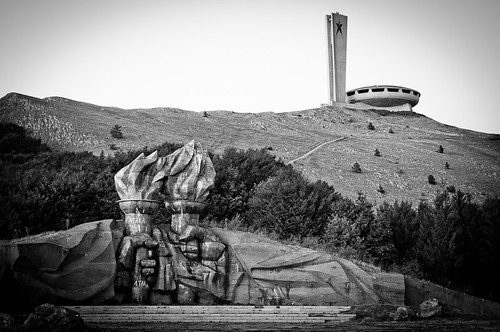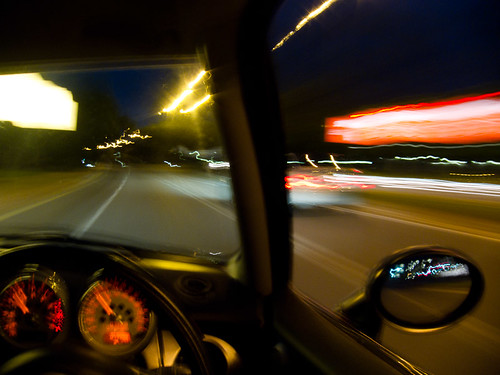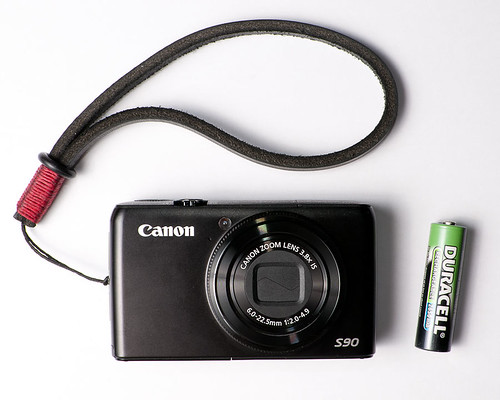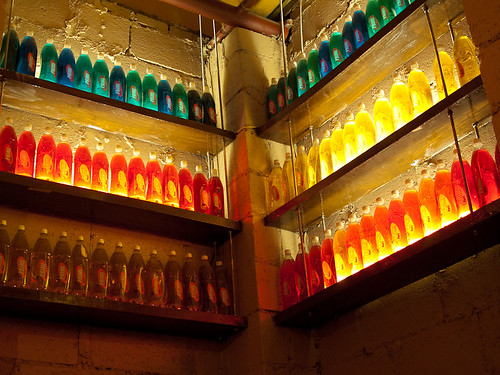Buzludzha
I've been sitting on a mountain of unprocessed photos (Hi, Valery! ![]() ) from earlier this year - finally got inspired to post a couple. Hopefully the trend holds and some more will appear in the near future.
) from earlier this year - finally got inspired to post a couple. Hopefully the trend holds and some more will appear in the near future.
Sushi and compact camera musings
I have had my Canon S90 for nearly a year! Quite hard to believe - in fact Canon has already announced an update is due out soon (S95). Apparently the rear dial doesn't turn freely anymore on the S95 but I haven't actually found that the loose one on the S90 has been the problem many feared it might be. I like that they've added extra holes for a proper neck strap though - that seems like it could be useful.
If there was one thing that would make me want to upgrade, it would be the ability to attach a dedicated optical finder. I know Canon would rather have me buy the G11 for that but those cameras are simply too big once you've tried the S90 (not to mention the lens is a stop slower!)
I would imagine such a device using a proprietary clip instead of the usual flash shoe to keep the size down; perhaps with an extra frame marked for 50mm FoV. It doesn't need to be super-accurate, although large and bright would be very desirable. For bonus points, the finder could incorporate a focus indicator LED and illuminated frame lines that switch as you zoom the lens - I'm sure many people would pay good money for this.
I often find that I am holding my camera up to my eye, zoomed all the way out and pre-focused, just trying to eyeball the correct framing. It works surprisingly well! Some enterprising users have already hacked (well, glued) finders onto the S90 but a first party solution would be far more elegant. Mike Johnston recently likened these cameras to the original Leica; I think a proper finder would really cement the argument.
Lightroom tells me that my catalogue only has about 750 shots from the S90. It's not much but I have some travels coming up so that number should go up soon. More importantly, I have a very large number of keepers - about 150 are marked 3+ stars - and most of these are in difficult low-light situations where most compacts would struggle to deliver much in the way of usable pictures. These are 150 shots I would not have made with my DSLR because it was sitting at home!
On a related note, I managed to drop mine a short distance onto some gravel. Luckily it escaped with nothing but a mark or two on the lens ring paint - easily sorted with some black permanent marker ![]() The build quality (while not up to Leica M standards) is also more than adequate!
The build quality (while not up to Leica M standards) is also more than adequate!
Shot info: f/2.2, 6.85mm (one step from full wide), ISO 1600, CR2 converted through Lightroom 3.
Nikon does fashion
Some random backstage and runway shots from Africa Fashion Week, taken last Thursday -
Shot with a Nikon D700 and a selection of fines Nikkors: 14-24/2.8, 24-70/2.8, 70-200/2.8 VR2, 105/2.8 VR. If I had to pick a favorite lens it would definitely be the 14-24/2.8, with the 105/2.8 VR Micro-Nikkor coming a close second. They are all, without exception, big and heavy lenses I wouldn't want to carry around all the time but they certainly produce the goods when needed!
Canon PowerShot S90
I've had a Canon S90 for a couple of months already and in that short time have already managed some really nice shots. It's barely larger than a candybar cellphone and the picture quality beats anything I've seen from a similar-sized cameras. I always felt the G10 is a touch too big to carry at all times, and the S90 fits this role perfectly. Lightroom 3 handles the noise really well if you shoot raw, though you will definitely need something like PTLens to straighten up the barrel distortion at the wider settings (if you shoot JPEG the camera corrects it internally but only partially; PTLens can fully correct the JPEGs too). As with other PowerShots, the IS is unbelievably good - here is a hand-held sample at half a second:
And to illustrate just how tiny it is - here's mine next to an AA battery (you might also recognize the Gordy's camera strap it's wearing):
Nikon expert Thom Hogan has posted his views on the S90 and sums it up much better than I could. I find the S90 a great camera for those times when I don't feel like lugging my SLR around. And since I've had a chance to handle the Olympus E-P1, I really don't lust after a m4/3 camera anymore even though I'm sure it's technically a better proposition.
Lightroom 3 Beta begins with big improvements in image quality
I have been using Lightroom since one of the early pre-1.0 beta releases, and have enjoyed using it ever since. The release of the first public beta of Lightroom 3 last week was naturally an interesting event – what have they cooked up this time? According to the official release notes the major improvements are in the ACR rendering engine which processes raw sensor data into nice looking images. However I just wasn’t seeing any of the supposed improvements when looking at my files! Eventually I realized my mistake – because I imported some DNG files which had already been through Lightroom 2, the new beta was using the same old “process” in order to maintain the same appearance. As Larry Wall would say – “this is not a bug, it’s a feature!”
Lightroom was actually doing the right thing by preserving the original look of the images. All that was needed was to either reset the development settings (killing my adjustments in the process), or update to the latest process version (this is available from the Settings menu when in the Develop module). I have noticed that some of my images require a lot less sharpening under the new process and so would look rather over-sharpened when simply converted to the latest process. In other words there is a good reason why Lightroom does not automatically put your old images through the new process – it’s different enough that the results of your original adjustments may simply not look as good as they should. My advice would be not to do large-scale en masse conversion of entire folders or catalogs, rather convert individual images and reassess the adjustments made.
Now that I am seeing the output of the latest rendering engine, I can tell you that this alone will be worth the price of the upgrade for me. Colour noise handling is vastly improved, the luminance grain is tighter and there may even be a tad more detail visible in some borderline cases. Have a look at the following side by side crops and judge for yourself (click to see in full):
All files use the default Lightroom noise reduction settings – the colour noise reduction slider was set to 25, and luminance noise was set to 0.
The improvement in the G10 images is very impressive. Also note the much reduced vertical banding in the 50D ISO3200 sample #4 above (this is the only crop that is not 100% because the banding was not as obvious at the 1:1 magnification size). Overall, I am seeing ever so slightly more detail (e.g. the stitching in sample #2, eyebrow hairs in sample #3) and vastly reduced colour noise with a more pleasing grain pattern. The Nikon D700 does not show a huge improvement – I had to go through quite a number of ISO 6400 photos to find one that shows much of a difference, mostly because the files are so good to start with. The story is similar with the Pentax K10D in that it doesn’t show much improvement – the files are fairly noisy in the first place and stay that way even under the new process.
All the above files have easily discernable differences at full-screen view on my HP LP2475w (24” 1920x1200 LCD, or around 30% magnification depending on which camera the file comes from), except for the Canon 50D @ ISO 400 and the two Pentax shots. The differences between Lightroom 2.5 and 3.0 Beta rendering for these three images are basically invisible at smaller magnifications.
Another small but important improvement that I’ve noticed is the smoother movement of the adjustment sliders. Previously, some computationally-expensive adjustments would make the sliders very notchy as the image preview was being rendered every time you changed a value. Now the sliders can move freely all the time. This is a classic case of better use of multithreading leading to more responsive software. I haven’t done any actual testing but it seems as though the new beta is also utilizing my dual core CPU better during import/export. It only makes sense as CPUs with four or eight threads of execution are becoming increasingly popular, and Lightroom 2 has some known deficiencies in such configurations.
The Lightroom 3 beta is available to all at Adobe Labs (free registration required).
Canon G10 Gallery
While we wait for the G11 and S90 to show up, I uploaded some favorites that I've shot over the last couple of months with the G10.
Gordy’s Camera Straps
I never use the bundled neck straps for their intented purpose - usually I end up wrapping them a couple of times around my wrist so they don't get in the way too much. On occasion I might carry a camera over my shoulder on its strap but if it's out it's usually in my hand. Gordy's Camera Straps is a purveyor of finely crafted leather straps of all shapes and sizes. My black leather wrist strap arrived a couple of weeks back and I've been very happy with it. It's primarily intended to work with a compact camera but I discovered that it works just great with a much bigger DSLR too. The quality is outstanding and, depending on your style of shooting, this could be the perfect accessory to add a little retro flair to your camera of choice.
Here are a few shots of what it looks like on my G10 and K10D:
Also check out the customer gallery on Gordon's website which showcases many the different styles and colours available.
Verdict: highly recommended! (It should match my future S90 quite nicely, methinks.)
Canon S90 looks promising
Canon has just announced a duo of high-end compact digital cameras, the G11 and S90. The G11 is the successor to the highly acclaimed G10 not-quite-pocketable digicam which generated numerous rave reviews last year. Suffice to say that at ISO 80 to 200, shooting raw, the G10 produces outstanding results. The G11 adds a flip-out LCD (never been a big fan myself) and a new sensor with *lower* pixel count for improved low-light sensitivity. The trouble with the G10 is that, while compact by DSLR standards, it just isn't small enough to carry at all times. This is exactly where the S90 comes in - same sensor, even faster lens (f/2.0 at 28mm equiv.), and a new twist on the control dial scheme (if you'll excuse the bad pun), it could be just the right pocket camera.
Pixel densities compared - Canon G10, Canon G11, Nikon D90, Nikon D700. They are 34 MP/cm², 23 MP/cm², 3.3 MP/cm², and 1.4 MP/cm² respectively. Ok, a compact is never going to be anywhere near as light sensitive as even an APS-C DSLR, but f the new sensor delivers even a 1-stop improvement over the old one it would be great. Can't wait to get my hands on one!
Edit: I think Canon missed a trick with this one however. They should have left a small attachment point and released an optional external viewfinder, with brightlines for 28/35/50mm framing.
Kgalagadi Transfrontier Park
Small slide show from our recent adventures in Botswana ![]()
You can also view it large on Flickr.
Quickies
I have been writing exams during the last couple of weeks so not much time for posting. I wrote three so far, with very good results, and there is one more to go - Artificial Intelligence. I wonder if I can come up with an automaton that writes the exam for me? These should be the last papers I write for my BSc degree in Computer Science.
I just finished reading The Economist's special feature on the financial crisis from the October 11th 2008 edition. It's a fascinating, if long, read starting with When fortune frowned. On the subject of financial crises, one theory suggests a link between the number of Starbucks franchises and the state of a country's economy.
In case you have missed the mini banner on the blog, I published my first photo book with a collection of Orange River images. Check it out! I ordered one of all the available options, and they look great. I think my favourite is the Hardcover ImageWrap option. I will be ordering some more in time for Christmas! In the mean time Blurb has launched a premium grade paper option which should look even better.
The Pentax K-m has started shipping in the UK. Paired with the upcoming 15mm Limited prime lens, it should make one hell of a lightweight travel kit. (Pentax DSLRs use an APS-C sized sensor so the field of view would be equivalent to a ~23mm ultra-wide lens on a 35mm film camera.)
McLaren F1 chassis number 65 got sold at an auction for a record-setting £2.3m. Despite losing its top spot as the fastest production car some time ago, to many people it remains the supercar thanks its uncompromising and unique lightweight design.
Adobe's Creative Suite 4 might have only just began shipping, but Nvidia is quick to cash on it with the Quadro CX. As far as I can tell it is mostly just a rebranded GTX 260, and the only application that really benefits from it is video transcoding from Premiere. For Photoshop CS4, even the most basic cards should benefit from the new OpenGL-based image canvas based on Adobe's specs. The Nvidia Quadro CX does however offer dual DisplayPort interfaces and 30-bit colour so it's not all badge engineering.
And in gaming news, the Mirror's Edge demo is up on both Xbox Live and PSN as of today. I hope it lives up to the hype - it is busy downloading as I type.





